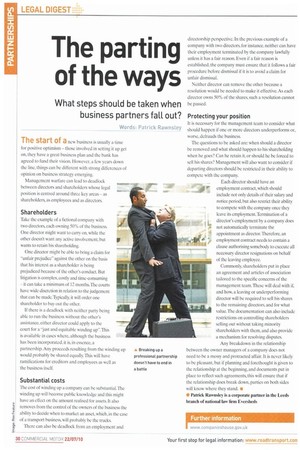The parting of the ways
Page 30

If you've noticed an error in this article please click here to report it so we can fix it.
What steps should be taken when business partners fall out?
Words: Patrick Rawnsley The start of a new business is usually a time for positive optimism those involved in setting it up get on, they have a great business plan and the bank has agreed to fund their vision. However, a few years down the line, things can be different with strong differences of opinion on business strategy emerging.
Management warfare can lead to deadlock between directors and shareholders whose legal position is centred around three key areas as shareholders, as employees and as directors.
Shareholders Take the example of a fictional company with two directors, each owning 50% of the business. One director might want to carry on, while the other doesn't want any active involvement, but wants to retain his shareholding.
One director might he able to bring a claim for "unfair prejudice" against the other on the basis that his interest as a shareholder is being prejudiced because of the other's conduct. But litigation is complex, costly and time-consuming it can take a minimum of 12 months, The courts have wide discretion in relation to the judgement that can be made. Typically. it will order one shareholder to buy out the other.
If there is a deadlock with neither party being able to run the business without the other's assistance, either director could apply to the court for a "just and equitable winding up". This is available in cases where, although the business has been incorporated, it is, in essence, a partnership. Any proceeds resulting from the winding up would probably be shared equally. This will have ramifications for creditors and employees as well as the business itself.
Substantial costs The cost of winding up a company can be substantial. The winding up will become public knowledge and this might have an effect on the amount realised for assets. It also removes from the control of the owners of the business the ability to decide when to market an asset, which, in the case of a transport business, will probably be the trucks.
There can also be deadlock from an employment and directorship perspective. In the previous example of a company with two directors, for instance, neither can have their employment terminated by the company lawfully unless it has a fair reason. Even if a fair reason is established, the company must ensure that it follows a fair procedure before dismissal if it is to avoid a claim for unfair dismissal.
Neither director can remove the other because a resolution would be needed to make it effective. As each director owns 50% of the shares, such a resolution cannot be passed.
Protecting your position It is necessary for the management team to consider what should happen if one or more directors underperforms or, worse, defrauds the business.
The questions to be asked are: when should a director be removed and what should happen to his shareholding when he goes? Can he retain it, or should he be forced to sell his shares? Management will also want to consider if departing directors should be restricted in their ability to compete with the company.
Each director should have an employment contract, which should include not only details of their salary and notice period, hut also restrict their ability to compete with the company once they leave its employment.Termination of a director's employment by a company does not automatically terminate the appointment as director. Therefore, an employment contract needs to contain a clause authorising somebody to execute all necessary director resignations on behalf of the leaving employee.
Commonly, shareholders put in place an agreement and articles of association tailored to the specific concerns of the management team.These will deal with if, and how, a leaving or underperforming director will be required to sell his shares to the remaining directors, and for what value. The documentation can also include restrictions on controlling shareholders selling out without taking minority shareholders with them, and also provide a mechanism for resolving disputes.
Any breakdown in the relationship between the owner managers of a company does not need to be a messy and protracted affair. It is never likely to be pleasant. but if planning and forethought is given to the relationship at the beginning, and documents put in place to reflect such agreements, this will ensure that if the relationship does break down, parties on both sides will know where they stand. •
• Patrick Rawnsley is a corporate partner in the Leeds branch of national law firm Eversheds
























































































































